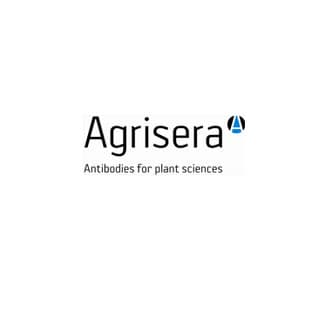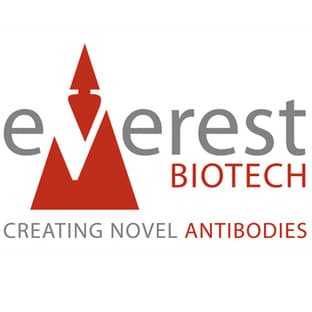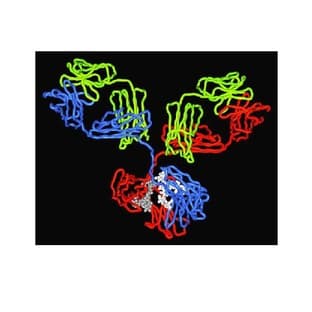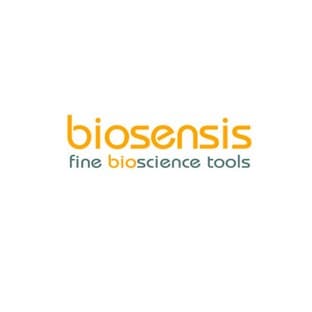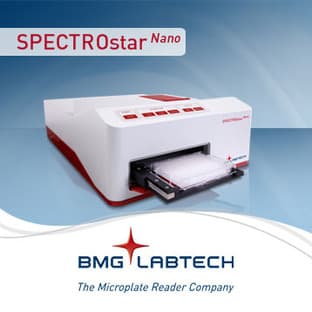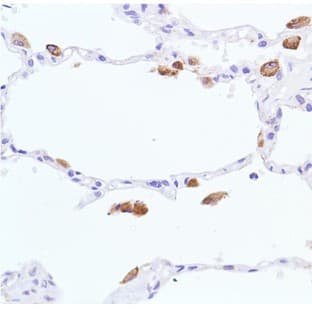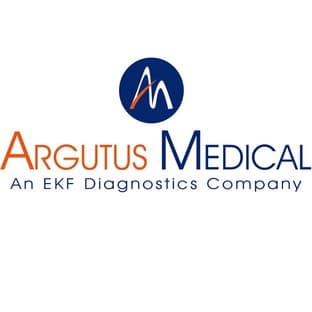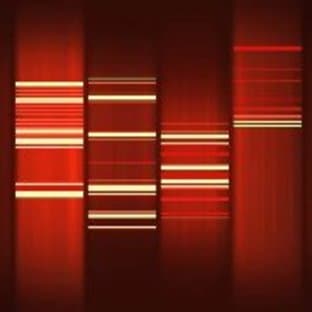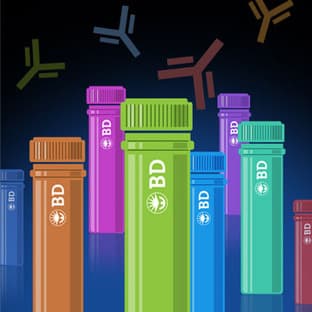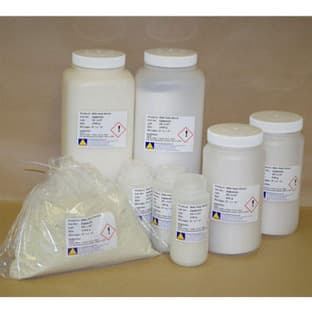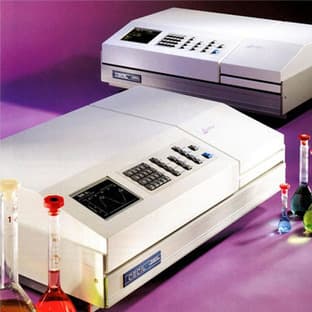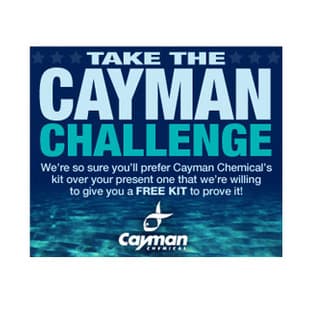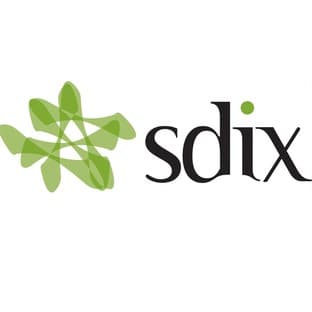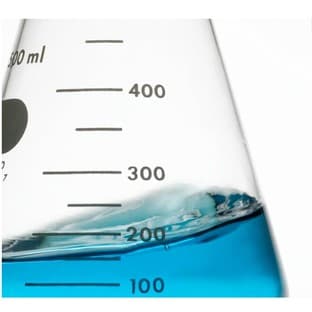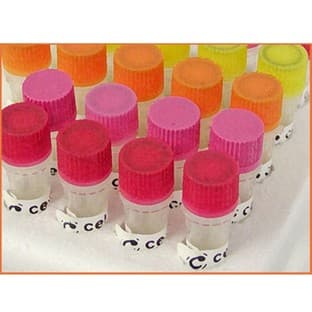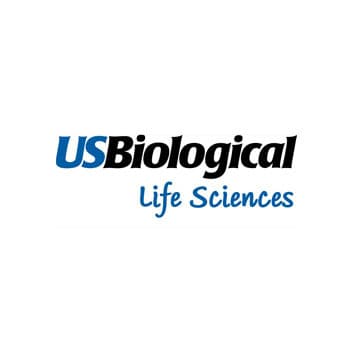
Supplier:
United States BiologicalCat no: H9810-01E
Hypoxia Inducible Factor 2a (Hypoxia Inducible Factor 2 alpha, Hypoxia Inducible Factor 2 alpha Subunit, HIF-2a, Endothelial PAS Domain Containing Protein 1, Endothelial Pas Domain Protein 1, EPAS1, EPAS-1, HIF-2 alpha, HIF2a, HIF1 alpha-like Factor, HLF,
Prices direct from United States Biological
Quick response times
Exclusive Biosave savings/discounts
SPECIFICATIONS
Catalog Number
H9810-01E
Size
100ul
Applications
ELISA, ICC, IF, IHC, IP, WB
Hosts
Rabbit
Reactivities
Hum, Mouse, Rat
Form
Supplied as a liquid in Tris-glycine, pH 7.5, 150mM sodium chloride, 0.05% sodium azide.
P Type
Pab
Purity
Purified by immunoaffinity chromatography.
Isotype
IgG
References
1. Alvarez-Tejado, M., et al. Journal of Biological Chemistry. 276(25): 22368-22374, 2001. 2. Alvarez-Tejado, M., et al. Journal of Biological Chemistry. 277(16): 13508-13517, 2002. 3. Asikainen, T.M., et al. PNAS. 102(29): 10212-10217, 2005. (Western blot, human) 4. Baba, M., et al. Oncogene. 22: 2728-2738, 2003. 5. Bernaudin, M., et al. Brain Genomic Response Following Hypoxia and Re-oxygenation in the Neonatal Rat: Identification of Genes That Might Contribute to Hypoxia-Induced Ischemic Tolerance. JBC Papers in Press. Published on July 26, 2002 as manuscript M204619200. 6. Biju, M., et al. V Mol. Cell. Biol 24: 9038-9047, 2004. 7. Block, K., et al. (2007) NAD(P)H Oxidases Regulate HIF-2{alpha} Protein Expression, 282, 8019-8026. 8. Bonicalzi, M., et al. Role of Exon 2-encoded beta-Domain of the von Hippel-Lindau Tumor Suppressor Protein. The Journal of Biological Chemistry. 276(2):1407-1416, 2001. 9. Bracken, et al. (2006) Stabilization and Transactivation in a Graded Oxygen Environment, 281, 22575-22585. 10. Burke, B., et al. Journal of Pathology. 196: 204-212, 2002. \n11. Calvani, M., et al. (2006) 107: 2705-2712. 12. Carroll, P. A., et al. (2006) 80: 10802-10812. 13. Chan, D., et al. Journal of Biological Chemistry. 277(42): 40112-40117, 2002.\n14. Chavez, J. C., et al. (2006) The Transcriptional Activator Hypoxia Inducible Factor 2 (HIF-2/EPAS-1) Regulates the Oxygen-Dependent Expression of Erythropoietin in Cortical Astrocytes, 26, 9471-9481.15. Conrad, P., et al Journal of Biological Chemistry. 274(47): 33709-33713, 1999. 16. Corn, P., et al.. Nature Genetics. 35: 229-237, 2003.17. Cuevas, Y., et al. Specific Oncolytic Effect of a New Hypoxia-Inducible Factor-Dependent Replicative Adenovirus on von Hippel-Lindau-Defective Renal Cell Carcinomas. Cancer Research 63, 6877-6884, October 15, 2003.\n18. de Paulsen, N., et al. Role of transforming growth factor-alpha in Von Hippel-Lindau (VHL)-/- clear cell renal carcinoma cell proliferation: A possible mechanism coupling VHL tumor suppressor inactivation and tumorigenesis. PNAS. 98(4): 1387-1392, 2001. (flow cytometry, western blot, human) \n19. Evans, A. J., et al. (2007) VHL Promotes E2 Box-Dependent E-Cadherin Transcription by HIF-Mediated Regulation of SIP1 and Snail, 27, 157-169.\n20. Franovic, A., et al. (2006) Multiple Acquired Renal Carcinoma Tumor Capabilities Abolished upon Silencing of ADAM17, 66, 8083-8090.\n21. Freeburg, P., et al. Divergent Expression Patterns for Hypoxia-Inducible Factor-1beta and Aryl Hydrocarbon Receptor Nuclear Transporter-2 in Developing Kidney. J. Am. Soc. Nephrol. 15: 2569-2578, 2004.\n22. Grabmaier, K., et al. Strict regulation of CAIXG250/MN by HIF-1 alpha in clear cell renal cell carcinoma. Oncogene.\n23. Graven,K., et al. HIF-2 alpha glyceraldehyde-3-phosphate dehydrogenase expression in endothelial cells. Biochimica et Biophysica ACTA. 93794:1-9, 2003.\n24. Grover, T. R., et al. (2007) Hypoxia inducible factors HIF- 1alpha and HIF-2alpha are decreased in an experimental model of severe respiratory distress syndrome in preterm lambs, 00372.02006.\n25. Gruber, M., et al. Acute postatal ablation of HIF-2 alpha results in anemia. PNAS 2007; 104; 2301-2306.\n26. Haase, V.H., et al. Vascular tumors in livers with targeted inactivation of the von Hippel-Lindau tumor suppressor. PNAS. 98(4): 1583-1588, 2001. \n27. Hergovich, A., et al. (2006) Priming-Dependent Phosphorylation and Regulation of the Tumor Suppressor pVHL by Glycogen Synthase Kinase 3, 26, 5784-5796.\n28. Hu, C-J., et al. Differential regulation of the transcriptional activities of hypoxia-inducible factor 1 alpha (HIF-1) and HIF-2 in stem cells. Mol. Cell Biol. 26:3514-3526, 2006.\n29. Hui, A. S., et al. (2006) Calcium signaling stimulates translation of HIF-{alpha} during hypoxia, 20, 466-475.\n30. Ietta, F., et al. Dynamic HIF-1alpha regulation during human placental development. Biol. Reprod. 2006. 75, 112-121.\n31. Khatua, S., et al. Overexpression of the EGFR/FKBP12/HIF-2alpha Pathway Identified in Childhood Astrocytomas by Angiogensis Gene Profiling. Cancer Research.63:1865-1870, 2003.\n32. Koizume, S., et al. (2006) Activation of Cancer Cell Migration and Invasion by Ectopic Synthesis of Coagulation Factor VII, 66, 9453-9460.\n33. Kojima, I., Tet al. (2007) Protective Role of Hypoxia-Inducible Factor-2{alpha} against Ischemic Damage and Oxidative Stress in the Kidney, ASN.2006060639.\n34. Kondo, K., et al. Inhibition of HIF is necessary for tumor suppression by the von Hippel-Lindau protein. Cancer Cell. 1: 237-246, 2002.\n35. Krishnamachary, B., et al. Hypoxia-inducible factor-1-dependent repression of E-cadherin in von Hippel-Lindau tumor supporessor-null renal cell carcinoma mediated by TCF3, ZFHX1A and ZFHX1B. Cancer Res. 66:2725-2731, 2006.\n36. Kurban, G., et al. Characterization of a von Hippel Lindau Pathway Involved in Extracellular Matrix Remodeling, Cell Invasion, and Angiogenesis. Cancer Res 2006; 66: (3), 2006.\n37. Liang, Y., et al. Activation of Vascular Endothelial Growth Factor A Transcription in Tumorigenic glioblastoma Cell Lines by an Enhancer with Cell Type-specific Dnase I Accessibility. Journal of Biological Chemistry. 277(22): 20087-20094, 2002.\n38. Lin, Q., Lee, Y.-J., and Yun, Z. (2006) Differentiation Arrest by Hypoxia, 281, 30678-30683.\n39. Luo, J.C., et al. A variant of nuclear localization signal of bipartite-type is required for the nuclear translocation of hypoxia inducible factors (1alpha, 2alpha and 3alpha). Oncogene. 20: 1435-1444, 2001.\n40. Lutz, M. S., and Burk, R. D. (2006) Primary Cilium Formation Requires von Hippel-Lindau Gene Function in Renal-Derived Cells, 66, 6903-6907.\n41. Mabjeesh, N, et al. Androgens Stimulate Hypoxia-inducible Factor 1 Activation via Autocrine Loop of Tyrosine Kinase Receptor/Phosphatidylinositol 3-Kinase /Protein Kinase B in Prostate Cancer Cells. Clinical Cancer Research: Vol. 9, 2416-2425, July 2003. \n42. Mabjeesh, N., et al. 2ME2 inhibits tumor growth and angiog1enesis by disrupting microtubules and dysregulating HIF. Cancer Cell. 3:363-375,2003.\n43. Mack, F., et al. Loss of pVHL is sufficient to cause HIF dysregulation in primary cells but dose not promote tumor growth. Cancer Cell. 3:75-88, 2003.\n44. MacKenzie, E. D., et al. (2007) Cell permeating {alpha}-ketoglutarate derivatives alleviate pseudo-hypoxia in SDH deficient cells, MCB.01927-01906.\n45. Makino, Y., et al. Inhibitory PAS domain protein is a negative regulator of hypoxia-inducible gene expression. Nature. 414: 550-554, 2001. \n46. Maranchie, J., et al. The contribution of VHL substrate binding and HIF-1alpha to the phenotype of VHL loss in renal cell carcinoma. Cancer Cell. 1: 247-255, 2002. \n47. Martin-Puig, S., et al. Role of Iron (II)-2-Oxogluterate-dependent Dioxygenases in the Generation of Hypoxia-induced Phosphatidic Acid through HIF-1/2 and von Hippel-Lindau-independent Mechanisms. J. Biol. Chem. 279: 9504-9511, 2004.\n48. Mekhail, K., et al. HIF activation by pH-dependent nucleolar sequestration of VHL. Nature Cell Biology.\n49. Michenko, A., et al. Hypoxia-inducible factor-1 (HIF-1) mediated expression of the 6-phosphofructo-2-kinase/fructose-2,6-biophosphatase-3 (PFKBF3) gene: its possible role in the Warburg effect. JBC Papers in Press. 277(8): 6183-6187, 2002.\n50. Miller, F., et al. Inactivation of VHL by tumorigenic mutations that disrupt dynamic coupling of the pVHL: HIF-1alpha complex. J. Biol. Chem. 280(9): 7985-7996, 2005. \n51. Mizukami, Y., et al. Hypoxia-Inducible Factor-1-Independent Regulation of Vascular Endothelial Growth Factor by Hypoxia in Colon Cancer. Cancer Research. 64:1765-1772, March 1, 2004.\n52. Mizukami, Y., et al. (2006) Hypoxic Regulation of Vascular Endothelial Growth Factor through the Induction of Phosphatidylinositol 3-Kinase/Rho/ROCK and c-Myc, 281, 13957-13963.\n53. Mohan, S., et al. von Hippel-Linau protein complex is regulated by cell density. Oncogene. 22: 5270-5280, 2003.\n54. Nakamura, K., et al. (2006) Brain-Derived Neurotrophic Factor Activation of TrkB Induces Vascular Endothelial Growth Factor Expression via Hypoxia-Inducible Factor-1{alpha} in Neuroblastoma Cells, 66, 4249-4255.\n55. Naranjo-Suarez, S., et al. Down-regulation of Hypoxia-inducible Factor-2 in PC12 Cells by Nerve Growth Factor Stimulation. Journal of Biological Chemistry. 278(34): 31895-31901, 2003.\n56. Niv, A., et al. Histologic Artrial Myolysis Is Associated With Atrial Fibrillation Cardiac Operation. The Society of Thoracic Surgeons. 72: 688-93, 2001.\n57. Ohh, M., et al. Ubiquitination of hypoxia-inducible factor requires direct binding to the Beta-domain of the von Hippel- Lindau protein. Nature Cell Biology. 2(7): 423-427, 2000. \n58. Okuyama, H., et al. (2006) Expression of Vascular Endothelial Growth Factor Receptor 1 in Bone Marrow-derived Mesenchymal Cells Is Dependent on Hypoxia-inducible Factor 1, 281, 15554-15563.\n59. Palayoor, S., et al. Ibuprofen-mediated Reduction of Hypoxia-inducible Factors HIF-1 alpha and HIF-2 alpha in Prostate Cancer Cells. Clinical Cancer Research. 9:3150-3157, 2003.\n60. Pan, Y., et al. p53 cannot be induced by hypoxia alone but responds to the hypoxic microenvironment. Oncogene.\n61. Park, S, et al. Hypoxia-Induced Gene Expression Occurs Solely through the Action of Hypoxia-Inducible Factor 1 alpha (HIF-1 alpha): Role of Cytoplasmic Trapping of HIF-2 alpha: Molecular and Cellular Biology, July 2003, p. 4959-4971.\n62. Peso, L., et al. The von Hippel Lindau/Hypoxia-inducible Factor (HIF) Pathway Regulates the Transcription of the HIF-Proline Hydroxylase Genes in Response to Low Oxygen. Journal of Biological Chemistry. 278(49):48690-48695, 2003.\n63. Rajakumar, A., and Conrad, K. Expression, Ontogeny, and Regulation of Hypoxia-Inducible Transcription Factors in the Human Placenta. Biology of Reproduction. 63: 559-569, 2000. \n64. Rathmell, W., et al. In Vitro and In Vivo Models Analyzing von Hippel-Lindau Disease-Specific Mutations. Cancer Research. 64: 8595-8603, 2004.\n65. Sato, M., et al. The PAI-1 Gene as a Direct Target of Endothelial PAS Domain Protein-1 in Adenocarcinoma A549 Cells. Am. J. Respir. Cell Mol. Biol. 31: 209-215, 2004.\n66. Schultz, K., Fanburg, B. L., and Beasley, D. (2006) Hypoxia and hypoxia-inducible factor-1{alpha} promote growth factor-induced proliferation of human vascular smooth muscle cells, 290, H2528-2534.\n67. Shinojima, T., et al. (2006) Renal cancer cells lacking hypoxia inducible factor (HIF)-1{alpha} expression maintain vascular endothelial growth factor expression through HIF-2{alpha}, bgl143.\n68. Smith, K., et al. Silencing of Epidermal Growth Factor Receptor Suppresses Hypoxia-Inducible Factor-2-Driven VHL-I- Renal Cancer. Cancer Res 2005; 65: (12), 2005.\n69. Staller, P., et al. Chemokine receptor CXCR4 downregulated by von Hippel-Lindau tumor suppressor pVHL. Letters to Nature. 425(18): 307-311. \n70. Takeda, K., et al. (2006) Placental but Not Heart Defects Are Associated with Elevated Hypoxia-Inducible Factor {alpha} Levels in Mice Lacking Prolyl Hydroxylase Domain Protein 2, 26, 8336-8346.\n71. Takeda, N., et al. Endothelial PAS Domain Protein 1 Gene Promotes Angiogenesis Through the Transactivation of Both Vascular Endothelial Growth Factor and Its Receptor, Flt-1. Circ. Res. 95: 146-153, 2004.\n72. Tang, N.,et al. Loss of HIF-1 alpha in endothelial cells disrupts a hypoxia-driven VEGF autocrine loop necessary for tumorigenesis. Cancer Cell. 6:485-495, 2004. (Western Blot, Mouse).\n73. Temes, E., et al. Activation of HIF-prolyl hydroxylase by R59949, an inhibitor of the diacylglycerol kinase. J. Biol. Chem. 280(25): 24238-24244, 2005. (Western blot, human)\n74. Toro, R., et al. Induction of T-type Calcium Channel Gene Expression by Chronic Hypoxia. Journal of Biological Chemistry. 278(25): 22316-22324, 2003.\n75. Uchida, T., et al. Prolonged Hypoxia Differentially Regulates Hypoxia-inducible Factor (HIF)-1 alpha and HIF-2 alpha Expression in Lung Epithelial Cells: Implication of Natural Antisense HIF-1 alpha. Mechanisms of Signal Transduction. 279: 14871-14878, 2004.\n76. Welsh, S., et al. Antitumor activity and pharmacodynamic properties of PX-478, an inhibitor of hypoxia-inducible factor-1alpha. Mol. Cancer Ther. 3: 233-244, 2004.\n77. Xia, G., et al. Positive expression of HIF-2 alpha / EPAS1 in invasive bladder cancer. Elsevier. 59(5):774-778,2002.\n78. Yuan, Y., et al. Cobalt Inhibits the Interaction between Hypoxia-inducible Factor-alpha and von Hippel-Lindau Protein by Direct Binding to Hypoxia-inducible Factor-alpha. Journal of Biological Chemistry. 278(18): 15911-15916, 2003.\n79. Zhang, H., et al. Cancer Cell 11. 407-420. May 2007.\n80. Zimmer, M., et al. Inhibition of hypoxia-inducible factor is sufficient for growth suppression of VHL-/-tumors. Mol. Can. Res. 2:89-95, 2004. (Western blot, ELISA, human/mouse)\n81. Takeda, K., et al. Placental but Not Heart Defects Are Associated with Elevated Hypoxia-Inducible Factor {alpha} Levels in Mice Lacking Prolyl Hydroxylase Domain Protein 2. 26: 8336-8346, 2006.\n82. Koizume, Shiro., et al. Molecular Biology, Pathobiology, and Genetics: Activation of Cancer cell Migration and Invasion by Ectopic Synthesis fo Coagulation Factor VII. 66: 9453-9460, 2006.\n83. Nagano, M., et al. Identification of functional endothelial progenitor cells suitable for the treatment of ischemic tissue using human umbilical cord blood. Blood, Jul 2007; 110: 151 - 160.\n84. Milkiewicz, M., J. L. Doyle, et al. (2007). HIF-1{alpha} and HIF-2{alpha} play a central role in stretch-induced but not shear-stress-induced angiogenesis in rat skeletal muscle. 583: 753-766.
Additional Info
Recognizes human Hypoxia Inducible Factor 2a. Does not crossreact with HIF-1 alpha. Species Crossreactivity: mouse, rat, fish
SUPPLIER INFO
Applications
ELISA
Reactivities
Hum
Applications
IF
Hosts
Mouse
Applications
ELISA, WB
Hosts
Mouse
Reactivities
Hum
Applications
ELISA, FC, WB
Hosts
Mouse
Reactivities
Hum
Applications
ELISA, FC, IHC, WB
Hosts
Mouse
Applications
IHC, WB
Hosts
Rabbit
Reactivities
Hum
Applications
ELISA, WB
Hosts
Rabbit
Reactivities
Hum
Latest promotions
Spend less time on DNA cleanup so you can do more science. The MSB Spin PCRapace is the fastest way to purify your DNA from PCR, restriction digestion, and...
New brilliant antibodies, and new lower prices!For flow cytometry reagents in general, \"bright is better.\" The violet-excitable BD Horizon™ BV421 and...
As an incentive to qualify our BSA, we are offering a 20% discount when you purchase your first 100g, 500g or 1000g of any grade of Bovine Serum Albumin....
It is not every day that you are given something for nothing. We are giving away additional spectrophotometer software.Cecil Instruments have enhanced the...
We're so sure that you'll prefer Cayman Assay kits over your present brand that we're willing to give you a free assay kit to prove it!
10% Discount on 2 Rabbit Polyclonal Antibody Service. With over 20 years experience, SDIX has developed into the premier US custom antibody producer,...
For the past decade scientists have extensively used ATS secondary toxin conjugates to make their own targeted toxins for in vitro use.The ability to combine...
Did your supplier increase the price of Fetal Bovine Serum? Did they substitute the US Origin with USDA? Well say no more! Innovative Research is still...
Bulk Cytokines with Custom Vialing.20 - 50% off cytokines, growth factors, chemokines and more...For a limited time Cell Sciences is offering substantial...
Jenway’s 73 series spectrophotometer range provides four models with a narrow spectral bandwidth of 5nm and an absorbance range of –0.3 to 2.5A,...
Are you planning to have a customised antibody made for your research?Since 2000, Everest has been producing a catalog containing thousands of affinity...
Top suppliers
United States Biological
230753 products
Carl Zeiss Microscopy
27 products
Promega Corporation
11 products
Panasonic Healthcare Company
5 products
Life Technologies
1 products
Nikon Instruments Europe
11 products
Olympus Europa Holding GmbH
3 products
Leica Microsystems, Inc.
10 products
GE Healthcare Life Sciences
2 products
Tecan Trading AG
19 products
Beckman Coulter, Inc.
1 products
AB SCIEX
3 products
BD (Becton, Dickinson and Company)
1 products
RANDOX TOXICOLOGY
5 products
Randox Food Diagnostics
6 products
